#hanamatsuri
中設楽の花祭り 2019年12月8日

My camere does not work well. I must repair it. This is the only photo that I can post here (T_T)
Various gods, some are from myth of Japan(古事記Kojiki)
神話世界の神々、河内の花祭りにて

Kochi’s Hanamatsuri has two layers. The base layer is ordinary Hanamatsuri, and story derived from ‘Kojiki’ is newer layer. In this festival most remarkable program is '大蛇退治OROCHI TAIJI’ (annihilating huge snake). Of course this is a famous story in Kojiki. A mythical hero 素戔嗚SUSANO defeated an evil huge snake having eight heads by his clever scheme.
Now Let’s look at festival yard. We can see a great oni, its name is SUSANO.
河内の花祭りは二重構造になっています。本来は普通の花祭りだったものに、記紀神話がか覆いかぶさってきていると言えば良いでしょうか。神話の内容を取り込んだものになっています。「大蛇退治」という演目では、登場する鬼はスサノオノミコトと呼ばれ、獅子が八岐大蛇(やまたのおろち)の代役を務めます。
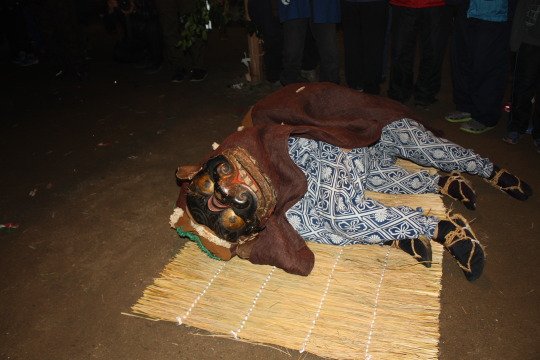
A Shishi(lion) entered the yard. But in this program it plays a role of huge snake called YAMATA NO OROCHI. By SUSANO’s scheme OROCHI had got drunk and lay down. SUSANO (oni) approached it and ,,,,
古事記にある通り、八岐大蛇(代 獅子)は酒に酔っぱらって地に伏します。そこへ、スサノオノミコトが近づいて
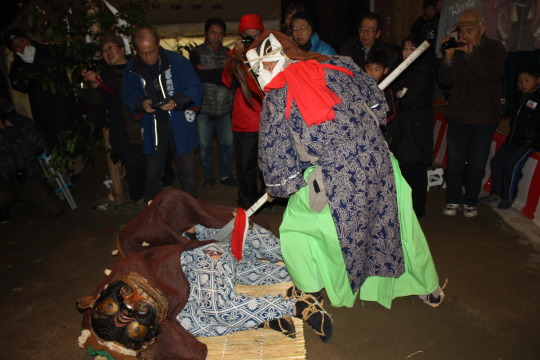
槍でグサッ。ひとしきりバトルがあり、スサノオノミコトは倒れ伏した獅子の体内から 天叢雲剣(あめのむらくものつるぎ)を取り出します。(獅子の後ろ足役の人が小剣を素戔嗚に手渡すのが、私の位置から見えました)
He stung Orochi with lance. The two fought for a while. But soon the god won. He took the sword from Orochi’s body. It is called AMANO MURAKUMO NO TSURUGI. (It is one of Three Sacred Treasures.This sword and other two treasures are things that prove their owner to be Japanese emperor, even today).

ほうほうの体で逃げたず八岐大蛇
At last Orochi escaped
Various gods, some are from myth of Japan(古事記Kojiki)
神話世界の神々、河内の花祭りにて

アメノウズメノミコトAMENOUZUMENOMIKOTO
Many villages in Shitara area have Hanamatsuri festival. Some of them are different from other usual Hanamatsuri in the aspect of having stories like a stage drama. The stories came from myth of Japan(古事記 Kojiki).
河内の花祭りは、記紀神話に由来する演目がいくつかあるというのが特色です。
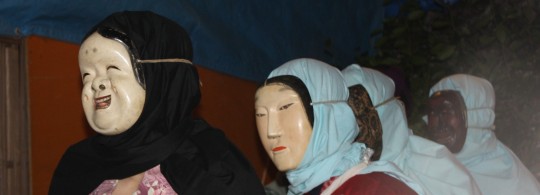
AMENOUZUME and her followers アメノウズメとその従者

翁 OKINA
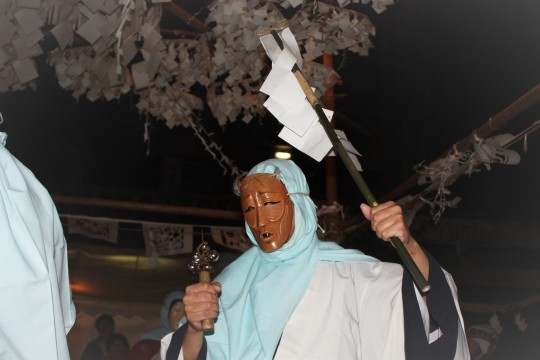
ひのねぎHINONEGI
Various gods, some are from myth of Japan(Kojiki)
神話世界の神々、河内の花祭りにて
Many villages in Shitara area have Hanamatsuri festival. Some of them are different from other usual Hanamatsuri in the aspect of having stories like a stage drama. The stories came from myth of Japan(古事記 Kojiki).
河内の花祭りは、記紀神話に由来する演目がいくつかあるというのが特色です。
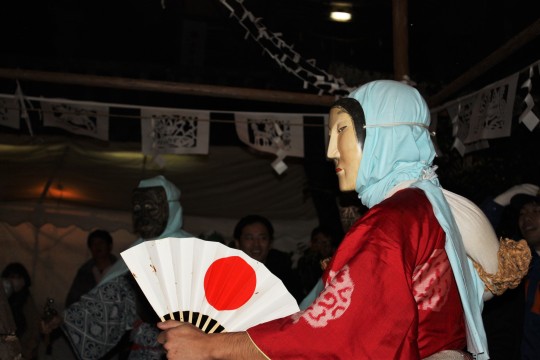

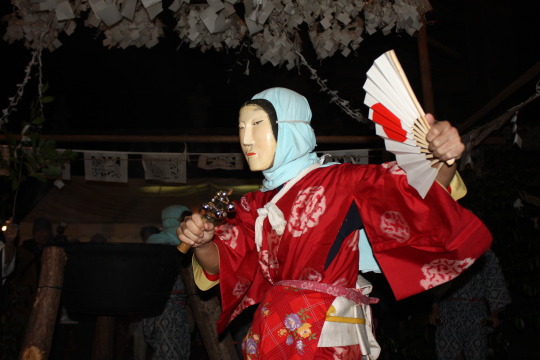
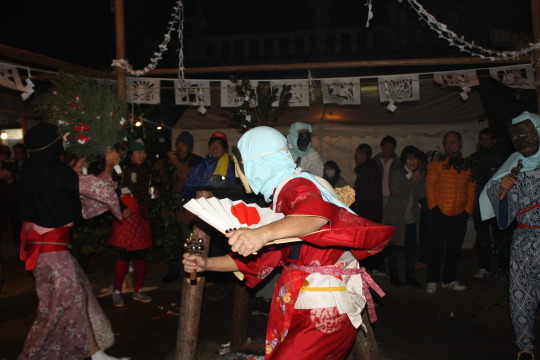
愛知県北設楽郡東栄町月の花祭り
A festival of winter solstice. Our ancestors believed their spirits got weaken at the season. So they held festival of water and fire in order to get new energy. This is also a festival of rebirth.
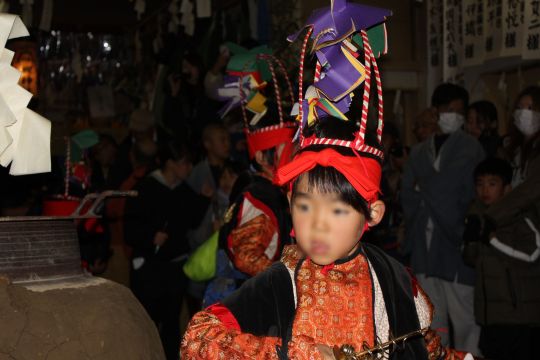



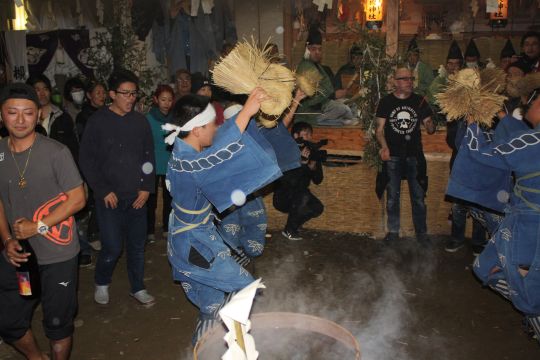
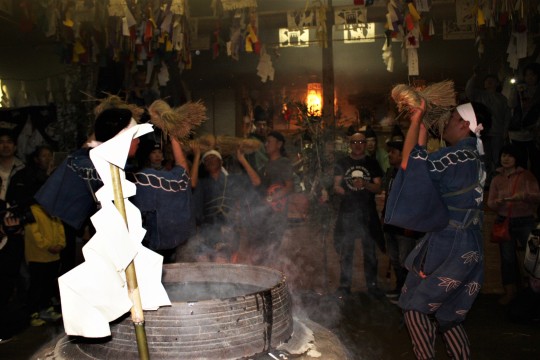
2019 東薗目の花祭
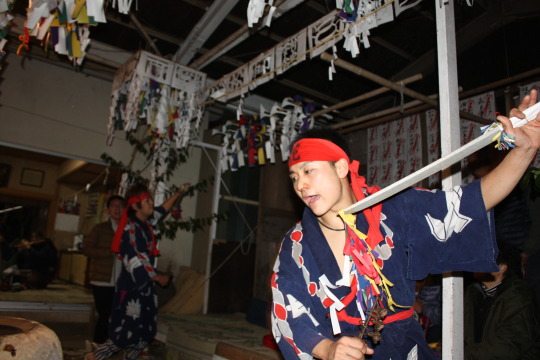

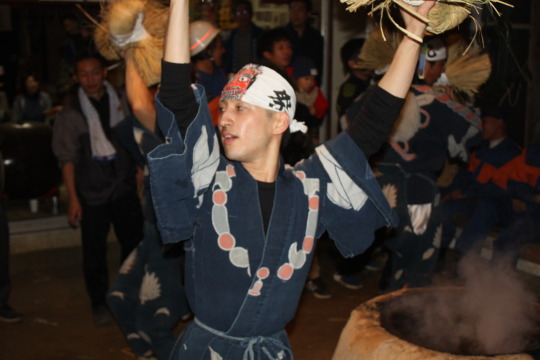

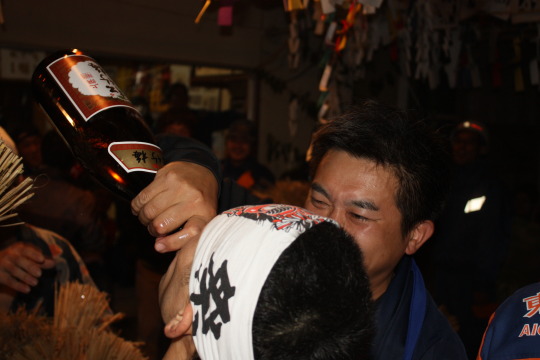
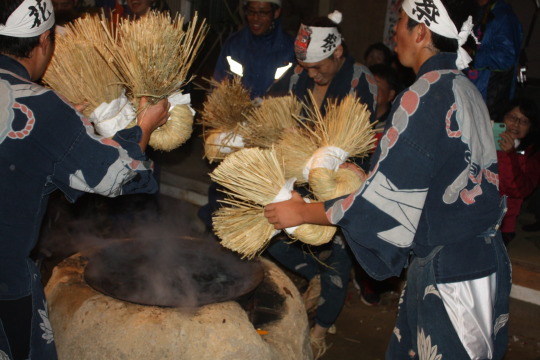
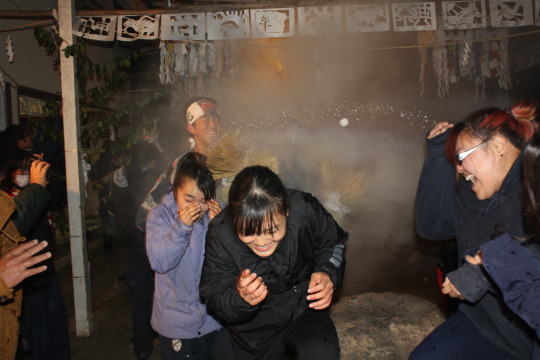
The festival of rebirth. They believe this holy hot water make their spirits vivid and their bodies healthy. 聖なる水と炎による生まれ清まりの祭り。冬至のころ、肉体と魂の再生を期して行われる湯立神楽です。
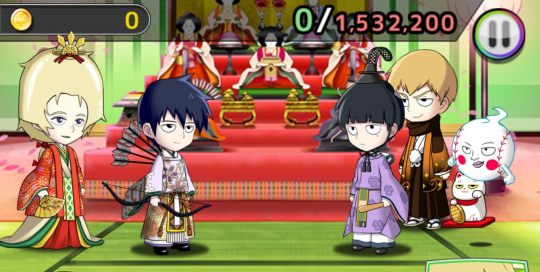
In Mob Puz’ new event, as same as the traditional occasion that is currently happening in Japan, we are joining their girl’s celebration that is Doll event or also known as Hina Matsuri. I already shared a post about it just a few days ago about how the dolls are placed in a step altar. Now, considering we have 5 new limited characters from Mob Psycho 100 as dolls as shown already, I figured out where to place them based from the blog sources I found. I also included the others that aren’t mentioned based from my creative imagination of my mind. I’m also looking forward for a step altar fanart that is arranged traditionally according to Japanese culture and customs by looking at the following information below. Let’s say this is a challenge for all artists out there
Now, going down to the Hina-Ningyo placements using the Mob Psycho 100 characters. In Japan, You can’t just arrange the dolls how you’d like, and wouldn’t you believe it’s actually quite complex. Some additional information that was already been shared/posted but it’s still quite important because of this gorgeous occasion (for girls):
The dolls themselves are usually acquired by the family after the first girl is born; either by inheriting them, as a gift from the grandparents, or by simply purchasing themselves. This custom of putting dolls on display is said to have begun during the Heian period (794-1185), and as such the dolls are all modeled after the hierarchy of the imperial court during that time.
Some Hina-Ningyo displays are very extravagant and elaborate.
Traditionally they are arranged and displayed on a five or seven-tiered stand covered with a red carpet. Sets can range from a few hundred-thousand yen to up in the millions! Although, due to the cost and limited space, it is now common to see smaller versions on display in homes. In fact, today it is most common to only display the very top-tier.
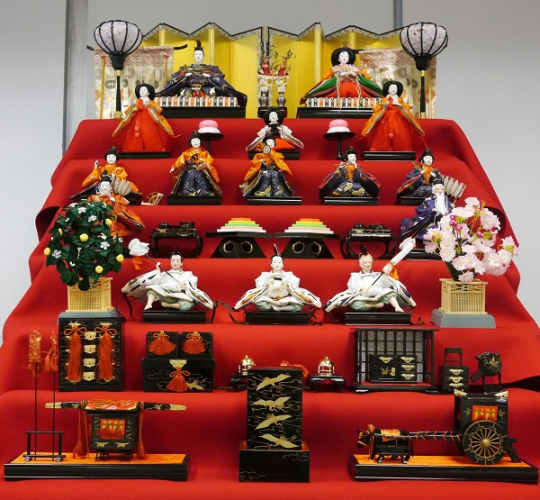

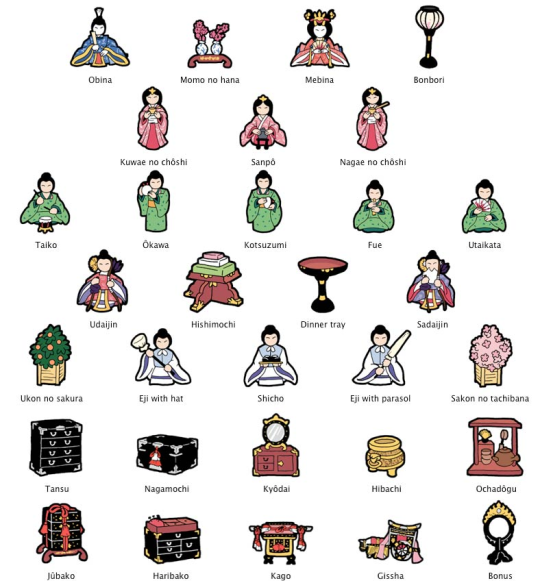
First platform:
The top-tier holds the two most important dolls. These dolls represent the Emperor, called Odari-sama (御内裏様) who is holding a ritual baton, and the Empress, called Ohime-sama (御雛様) who holds a fan. Using MP100 characters, as already showed in the game, the top tier includes Emperor Mob and Empress Teru.
Between them you’ll see an arrangement of two vases of peach blossoms called a sanbo kazari (三方飾) i or in other term known as Momo no hana, and to the outside of the platform there are bonbori (雪洞), paper lanterns decorated with plum blossoms or cherry blossoms which represent the spring season. In traditional arrangements the female is seated at the right side of the male doll, because historically the Empress was always seated to the right side of the Emperor. However, in the 20th century the Empress began to sit on the Emperor’s left side. You’ll find this change has since been incorporated in the modern Hina-Ningyo placements– except in Kyoto where they still place them in the original, traditional position.
Second platform:
In the second tier are the three court ladies, sannin kanjo (三人官女),and each one is holding some form of sake equipment.
From left to right:
- Kuwae no choushi (加えの銚子): backup sake-bearer (standing)
- Sanpou (三方): sake bearer (seated)
- Nagae no choushi (長柄の銚子): long-handled sake-bearer (standing)
Since we don’t have court ladies presented in Mob Puz game, I will be using 3 ladies that are commonly showed in Mob Psycho 100, the left will be Emi, the middle will be Takane Tsubomi and the right will be Mezato Ichi
The accessories placed in between the ladies are called takatsuki(高坏), which are round-topped tables used for serving seasonal sweets. A dinner tray on above image is an image for it.
Third platform
This tier features five male musicians, gonin bayashi (五人囃子). Each one holds a musical instrument besides the singer, who holds a fan.
From left to the right:
- Taiko (太鼓) drummer (seated)
- Otsuzumi (大鼓) drummer (standing)
- Kotsuzumi (小鼓) drummer (standing)
- Fue (笛) or Yokobue (横笛) flautist (seated)
- Utaikata (謡い方), the singer (seated)
I will be using the 4/5 members of the Telepathy club as a dolls for this platform:
From left to right:
- Drummer (seated) - Inugawa
- Drummer (standing) - Kijibayashi
- Drummer (standing) - Saruta
- Flautist (seated) - Takenaka
- Singer (seated) - Kurata Tome
Fourth Platform:
The fourth tier displays two ministers (大臣, daijin), who are usually equipped with bow and arrows.
- Udaijin (右大臣): The Minister of the Right, who is on the left side.
- Sadaijin (左大臣): The Minister of the Left, who is portrayed as much older with a long white beard.
The Minister of the Right is depicted as a young person, while the Minister of the Left is much older.. Also, because the dolls are placed in positions relative to each other, the Minister of the Right will be on the viewer’s left and the Minister of the Left will be on the viewer’s right. Both are sometimes equipped with bows and arrows. Between the two figures are covered bowl tables kakebanzen(掛盤膳?), also referred to as o-zen(お膳?), as well as diamond-shaped stands hishidai(菱台?) bearing diamond-shaped ricecakes hishimochi(菱餅?).Hishidai with feline-shaped legs are known as nekoashigata hishidai(猫足形菱台?).
I will be using 3 characters that are already shown in the Mob Puz game, the MInister on the Right is Udaijin Ritsu, the Minister on the left is Sadaijin Reigen and Diamond shaped rice cakes whom is Hishimochi Dimple
Fifth Platform:
The fifth tier holds the three samurai protectors of the Emperor and Empress.From left to right:
- Nakijogo (泣き上戸):the maudlin drinker
- Okorijogo(怒り上戸):the cantankerous drinker
- Waraijogo (笑い上戸): the merry drinker
On the leftmost side there is a mandarin orange tree (ukon no tachibana 右近の橘), and one the rightmost is a cherry blossom tree (sakon no sakura左近の桜).
I will be using 3 guys from Body Improvement Club as the protectors of the Emperor and Empress.You are free to choose whoever from the 5 will be the 3 protectors on this platform since in the manga and anime, it’s also their duty and responsibility to look after their member whom is considered as one of their family like Mob. Goda Musashi must be included as one of the 3 here since like guys from BIC, he’s a really reliable president and of course a friend too.
Sixth Platform:
There are actually no dolls on the sixth tier, and instead used to display a variety of miniature items that can be found within the imperial palace. Common items include:
- Nagamochi (長持): a long chest used for kimono storage
- Kyodai (鏡台): a chest of drawers with a small mirror on top
- Tansu (箪笥): a chest of usually five drawers
- Hasamibako (挟箱): a small box used for storing clothes, it’s placed on top of the nagamochi
- Daisu (台子): utensils for a tea ceremony
- Haribako (針箱): a sewing kit box
- Hibachi (火鉢): two braziers
Seventh Platform:
Like the sixth platform, this level also contains no dolls. These items however are all things that can be found outside the imperial palace. Some common items are:
- Jubako (重箱): a set of lacquered food boxes tied together by a cord with a handle
- Goshoguruma (御所車): a carriage pulled by an ox
- Gokago (御駕籠): a palanquin
So there, I hope to see this in one of your fanart soon. Take it as a request from me but I’m not rushing anything so you are free to use your time whenever you want. Just in case you’ve finished it, please feel free to share your arts in fanart category of our discord server. Please be followed of the pinned rules over there
Web/Blog sources:Japan Travel in Translation,Japanese dolls tumblr blog andWikipedia
The next event is probably a doll festival or in other term known as Hina Matsuri. Here are some of the details I gathered as one of the traditional events held in Japan and is seen up to this time.


Every year on March 3rd, Japan celebrates the Doll Festival (Japanese, Hina Matsuri). Until recently, Girls’ Day was also celebrated on March 3rd. On this day every year, families set up a special step-altar on which to arrange their Emperor and Empress dolls, called “hina” in Japanese. They decorate this altar with boughs of peach blossoms and make offerings to the hina dolls of freshly made rice cakes (mochi), either flavored with a wild herb or colored and cut into festive diamond shapes. Here at the Kyoto National Museum, we hold an exhibition of dolls every year sometime between February and April in celebration of the Doll Festival.Look at the photos of these three altars below.
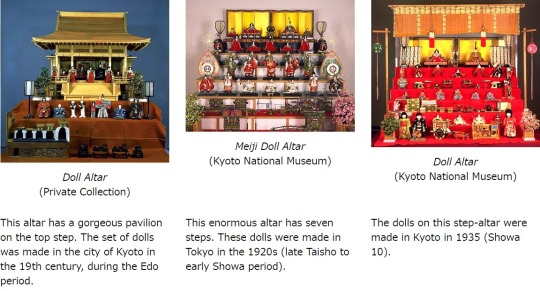
In addition to dolls, these altars display many beautiful and luxurious decorative accessories. Look again carefully at the three altars. Can you see any things displayed on the two altars made in Kyoto that are not on the altar made in Tokyo? The Kyoto-made altars have miniature kitchens and hearths for cooking. You will never see such objects on altars made in Tokyo because kitchen implements are a specialty of doll sets made in Kyoto. Tokyo dolls have their own specialties too; doll sets from Tokyo are tall with many steps. They also have many chests, shelves and other furnishings to display with the dolls. This kind of lavish exhibit is a Tokyo tradition that has been handed down since the Edo period. In fact, Edo is the old name for Tokyo. In the old days, you could quickly see the difference in style between doll sets made in Tokyo and those made in Kyoto. Today, however, these differences have almost disappeared.
Platforms covered with a red carpet are used to display a set of ornamental dolls (雛人形 hina-ningyō?) representing the Emperor,Empress, attendants, and musicians in traditional court dress of the Heian period.[3]. Families generally start to display the dolls in February and take them down immediately after the festival. Superstition says that leaving the dolls past March 4 will result in a late marriage for the daughter.[5]
So there, just some of the details you might also to know about this traditional event so look for that on Mob Puz by 2/27 and may the luck may be given to us to get all of those 5 new limited characters from the gacha and from the ranking reward.
Web Sources:Japanese Hina dolls andWikipedia
